May 11, 2007 — The next group of people to experience launching aboard one of NASA's space shuttles won't be astronauts. While NASA has June 8 planned for its next liftoff from Kennedy Space Center's Pad 39A, just seven miles away thousands at NASA's official visitor complex will have the opportunity to board the new Shuttle Launch Experience (SLE), opening on May 25.
The 44,000 square foot, $60 million ride — or as it's more accurately-described, simulator — was designed to give visitors to the Florida space center what they expressed they wanted most.
"We wanted to show people what it was like to fly in space because in our exit research, of the people who come here, it's all about launch," explained Dan LeBlanc, chief operating officer of the visitor complex, during an exclusive early tour of the SLE with collectSPACE.com.
"There were arguments about whether we should do shuttle... or whether we look at a futuristic [craft]. Our argument was, if you do future, than you are essentially science fiction and then there is no point of difference with what is going on 50 miles from here. We've got to stay real," stressed LeBlanc.
"There's no asteroids. There's no aliens. You don't even have an emergency on your way to orbit. In fact, we don't even tell people we're putting them on the shuttle. The marketing line is that this is a simulator. NASA had a lot to do with the early development of simulator technology and that's what it is, a motion based simulator designed by NASA and the astronauts to show people what it's like, as best we can within the confines of gravity, to fly to space aboard the space shuttle."
To accomplish that sense of realism, LeBlanc and his team turned to former astronauts like shuttle commander Rick Searfoss and Bob Rogers, founder and chairman of BRC Imagination Arts, a leader in the field of museum design. Rogers previously worked with the KSC Visitor Complex to design and build its Apollo-Saturn V Center.
"Rogers is our story teller, the same guy who did all the story telling out at the Saturn V, who took what is not a lot of twists and turns like on a roller coaster, but who took that experience and turned it into something really emotional," said LeBlanc.
"There's going to be a lot of learning going on in here but more than anything we want this to be emotional. We want to create an emotional attachment to the space program. We want people, after they do this, the next time they see a shuttle launch or a CEV launch, they can say, 'You know what, I know a little bit about what that feels like.'"
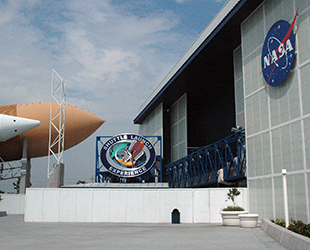
The entrance to the Shuttle Launch Experience, still blocked by temporary walls in early May 2007. (collectSPACE) |
Experiencing the Shuttle Launch Experience
Positioned at the Visitor Complex such that it neighbors static displays of a space shuttle external tank, solid rocket boosters and a mock-up, walk through orbiter, the Shuttle Launch Experience was designed with KSC's architecture in mind.
"It's meant to look like a hangar over on the cape side a little bit. It's meant to reminiscent of what you see on center, without being real specific," described Leblanc.
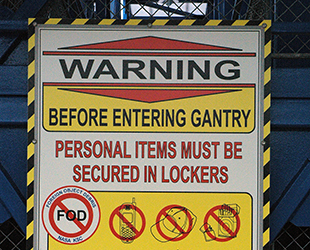
A warning sign cautions against FOD (Foreign Object Debris) and points visitors to lockers to stow their cameras, sunglasses and other items prior to riding. (collectSPACE) |
Visitors are first greeted by safety warnings ("You must be 48" tall to launch") before proceeding up a ramp that elicits the feeling of a launch pad's gantry.
"The first part of the ramp has graphics and then the top part has video monitors with astronaut interviews talking about the emotional aspects of launch. We've got John Young, we've got Crippen, we've got Gordon Fullerton..."
"This is where the story really begins," declared Leblanc.
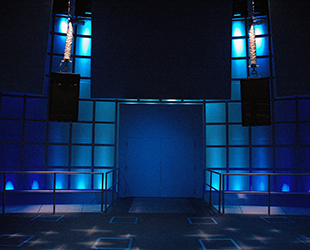
Visitors are first greeted by large projection screens and plasma monitors attached to robotic arms. (collectSPACE) |
Up to 180 visitors at a time enter a large room with three large screens and plasma monitors mounted on robotic arms. The platform has transducers in it to shake it and there is a fog effect.
"If this is going to be a straight forward launch, we are going to have to teach most of our guests what that involves. This [room] is where we are going to educate them and set up that whole experience inside. You are going to learn about that whole eight and a half minute process [to reach orbit], we're going to see that launch, there will be a fog effect, filling the area with smoke and the whole floor rattles," LeBlanc described.
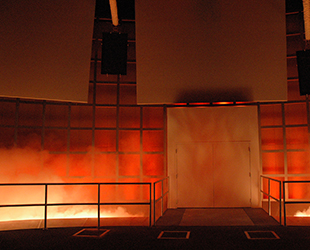
Lighting and fog effects, in addition to a shaking floor, help add to the experience of watching a shuttle launch. (collectSPACE) |
With the briefing over, guests exit the room through two doors at its front and enter the safety briefing area, a stretch of corridors that includes access to the four ride pods and the ride control room.
You're going to get broken in groups of 44. And it is here that we hint at, to make it real that 'there's 44 of you and you're not going to fit on the flight deck, so assume for this simulation we've created a cargo bay module. But the thing is, it would fit in the [real] cargo bay," LeBlanc said.
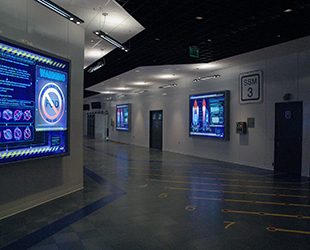
Guests are directed to one of four ride bays. (collectSPACE) |
"This is where you can opt out. From an ADA [American with Disabilities Act] standpoint, in front of the cabin, you're going to have transferrable seats. If you're not capable of doing the transfer, or you just don't want the motion, each bay will have a what we call a 'launch observation room'. The neat thing about that is if you go in there, you'll experience the audio of the vehicle, no motion, but we have a couple of unique things. We've got an on-board camera, so you can sit here and experience what your family is experiencing inside the cabin. And then there's the off-board camera, so you'll technically get to see the actual ride profile and what's happening from the outside. It's going to be a cool room," said LeBlanc.
"I think we have taken the ADA aspects of this, I think further than on any other motion-based ride. Providing something that even the people who ride the ride don't get, so when families reunite, you're both going to have stories."
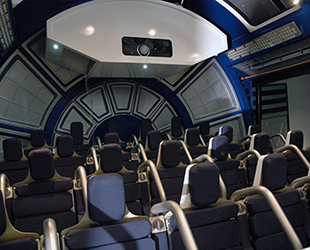
As 44 people wouldn't fit on the shuttle's flight deck, a special cargo bay module is used for this simulation. (collectSPACE) |
For those who can ride, they will board with the cabin level to the ground but will soon discover that it can pitch forward and back to some surprising results.
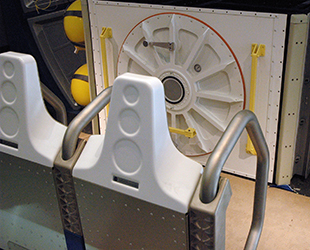
Special seats at the front of the cabin allow handicapped riders or the may wach rom an observation room. (collectSPACE) |
"To simulate g-forces and to put people into the launch position, you can't do that with your traditional simulator. So we pitch much further. And on top of that, we've got seats that do things as well. They don't move but they vibrate, they kick, they've even got air bladders in them to create that illusion of g-force by letting you sink back in your seat, or zero-g at the right time, pushing you out of your seat," explained LeBlanc. "That is the part I am most excited about."
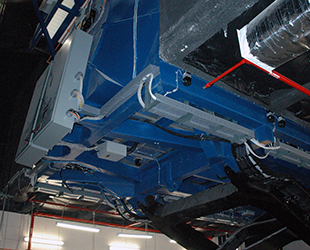
Behind the scenes: the view from below the ride system shows how far the cabin can pitch forward and back. (collectSPACE) |
After the ride ends, visitors exit down a spiral ramp that has a fiber-optic starfield above, rotating Earth below and along the path, plaques for every shuttle mission with the names of the crew, the mission designation and a line or two about what was accomplished.
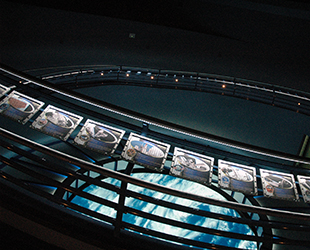
A spiral walkway leads visitors out of the Launch Experience while exhibiting plaques for each mission. (collectSPACE) |
"People aren't going to sit and read every one of these but what we want people to get out of this is that shuttle has flown a lot of times, launched many people and accomplished a lot. Especially that last message: even if they don't know what it is, if they know that the shuttle program was worthwhile, we've done our jobs, building that emotional connection and support for the program."
LeBlanc is quick to point out though, that the Experience doesn't end there.
"The best part of it, probably the best part of the whole ride is here: in this space is retail. It's a great looking gift shop, folks."
